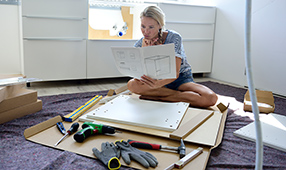You may be asking yourself how you’re going to pay for all your remodeling ideas. As a homeowner, you’re in an ideal position to use the growing equity in your home to finance home improvement projects. This is one of the smartest means of financing because it allows you to:
- Lower the cost of your remodel over the long run, because mortgage and home equity interest rates generally are lower than most other kinds of consumer credit.
- Potentially deduct the interest payments from your taxes, lowering your cost even more.
You can use your equity in two different ways:
- Mortgage refinancing. If current interest rates are favorable, you can replace your first mortgage with a new, larger mortgage that includes the cost of your remodeling project. In addition to this standard “cash-out” refinancing, lenders offer other products that give you even more money up front by adding in the value of the planned improvement. If you refinance your mortgage, you’ll keep the convenience of one home loan and one monthly payment.
- Home equity financing. Instead of refinancing, you can keep your existing mortgage intact, supplementing it with a home equity loan or line of credit. Home equity accounts let you use your current equity to pay for your home improvement projects.
Mortgage refinance or home equity financing—how do you decide?
It all boils down to the math. Find out how much each financing option will cost by checking current interest rates and monthly payments for each, considering the loan terms you desire. You’ll want to consider:
- Which option is more affordable? Calculate how much each of these options will cost, including the effect on your monthly payments as well as upfront costs and fees, some of which may be assessed at closing. Make sure you can pay for the loan terms that you select.
- What’s the ultimate cost of the loan? A 30-year mortgage can spread out your mortgage payments and lower your monthly costs, but you could wind up paying a lot more interest over the life of the loan. In addition, don’t forget to factor in the effects of the up-front costs and fees, some of which may be assessed at closing. Some homeowners would rather pay more principal each month and build their equity at a faster rate; some would not.












